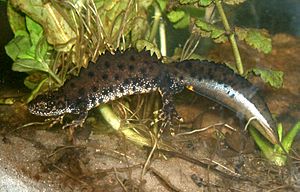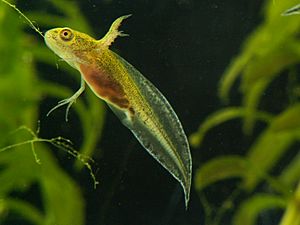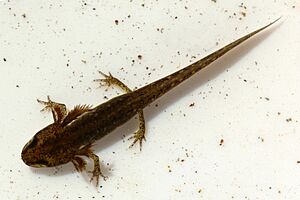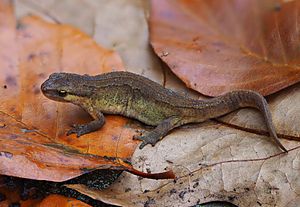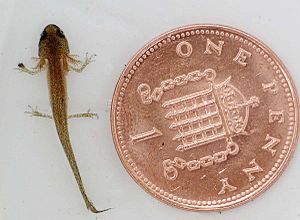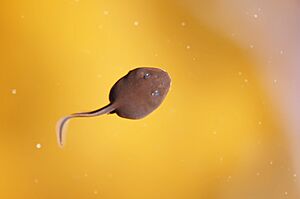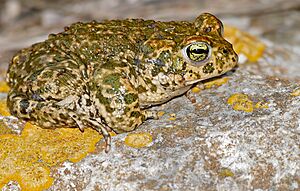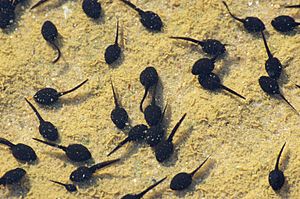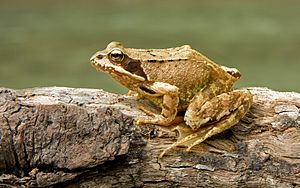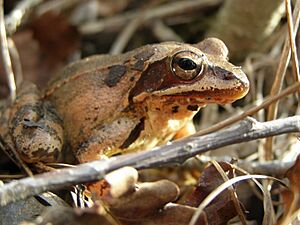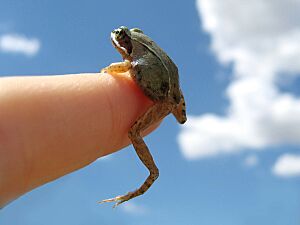List of amphibians of Great Britain facts for kids
Great Britain is home to many amazing creatures, including seven types of amphibians! Amphibians are special animals that can live both in water and on land. They start their lives in water, often as tadpoles or larvae, and then change as they grow, usually developing lungs to breathe air.
The native amphibians in Great Britain include three kinds of newts, two types of toads, and two kinds of frogs. All these native species are considered "least concern," which means they are not currently in danger of disappearing.
Contents
Amphibians Native to Great Britain
Meet the Newts!
Newts are small, lizard-like amphibians. They spend a lot of time in water, especially during their breeding season. Great Britain has three native newt species.
The Great crested newt (Triturus cristatus) is the largest native newt. It can grow up to 17 centimetres long. Males have a jagged crest along their back during breeding season, which looks a bit like a dinosaur's spine! They are often dark brown or black with a bright orange belly covered in black spots.
Their young, called larvae, have feathery gills on the outside of their heads to help them breathe underwater.
The Smooth newt (Lissotriton vulgaris) is the most common newt in Great Britain. It's smaller than the great crested newt, usually growing to about 10 centimetres. They are typically brown or olive green with a lighter, often spotted, belly. Males develop a wavy crest during breeding season.
Smooth newt larvae also have external gills and live in water until they are ready to move onto land.
The Palmate newt (Lissotriton helveticus) is similar in size to the smooth newt. Males have a small, thread-like tip at the end of their tail and dark webbing between their hind toes, which looks like little paddles. This is where they get their name "palmate."
Their larvae are also aquatic, breathing with external gills.
Terrific Toads!
Toads are amphibians that usually have dry, warty skin and tend to spend more time on land than frogs, especially when they are adults. They often walk rather than hop.
The Common toad (Bufo bufo) is widespread across Great Britain. It has bumpy, brownish-green skin and can grow quite large. They are known for their slow, deliberate movements.
Common toad tadpoles are small and black, often swimming in large groups.
The Natterjack toad (Epidalea calamita) is rarer than the common toad. It has a distinctive yellow stripe down its back and can run rather than hop. They prefer sandy habitats, like coastal dunes.
Natterjack toad tadpoles are also dark, but they often stay in shallower, warmer water.
The Spiny toad (Bufo spinosus) is found only on the island of Jersey in Great Britain. It looks very similar to the common toad but has more pronounced bumps or "spines" on its skin.
Fantastic Frogs!
Frogs are known for their smooth, moist skin and powerful long legs, which they use for hopping and jumping. They often live near water.
The Common frog (Rana temporaria) is the most widespread frog in Great Britain. It has smooth, moist skin that can be green, brown, or grey, often with dark patches. They are excellent jumpers.
Common frog tadpoles are dark and develop quickly in ponds and puddles.
The Pool frog (Pelophylax lessonae) is a rare native frog that was thought to be extinct in Great Britain but has been successfully reintroduced. They are typically green with a light stripe down their back and have a loud call.
The Agile frog (Rana dalmatina) is another native frog found only on Jersey. It has very long legs, making it an incredibly good jumper. Its skin is usually light brown or reddish-brown.
Agile frog tadpoles are similar to common frog tadpoles but can be found in different habitats.
Amphibians from Other Places (Naturalised and Escaped)
Sometimes, amphibians that are not native to Great Britain end up living here. This can happen if they escape from pets or if they are brought in by people and then start breeding in the wild. When a species starts living and breeding successfully in a new place, it's called "naturalised."
Here are some of the non-native amphibians that have been found in Great Britain:
- Fire salamander (Salamandra salamandra): This striking black and yellow salamander has bred at least once after escaping.
- Alpine newt (Ichthyosaura alpestris): This beautiful blue and orange newt has become naturalised in some areas.
- Italian crested newt (Triturus carnifex): Another type of crested newt that has been found.
- Midwife toad (Alytes obstetricans): This toad is famous because the male carries the eggs wrapped around his legs until they hatch. It has become naturalised in some places.
- Yellow-bellied toad (Bombina variegata): This toad has a bright yellow and black belly, which it shows off when threatened. Its current status in Great Britain is not fully known.
- Painted frog (Discoglossus pictus): This frog has bred at least once in the wild.
- European tree frog (Hyla arborea): These small, bright green frogs have sticky pads on their toes, allowing them to climb trees.
- Australian green tree frog (Litoria caerulea): Another tree frog that has bred after escaping.
- Marsh frog (Pelophylax ridibundus): This large, noisy frog is naturalised and can be found in many wetlands.
- Edible frog (Pelophylax kl. esculentus): This frog is a hybrid of the pool frog and marsh frog and is also naturalised.
- Iberian water frog (Pelophylax perezi): This frog from Spain and Portugal has also bred in Great Britain.
- American bullfrog (Lithobates catesbeiana): These very large frogs are originally from North America and have successfully bred here.
- African clawed toad (Xenopus laevis): These fully aquatic toads can live entirely underwater. Two populations survived in the UK for 50 years but are now mostly gone, except for a small group in Calderstones Park.
See also
 In Spanish: Anexo:Anfibios de Gran Bretaña para niños
In Spanish: Anexo:Anfibios de Gran Bretaña para niños


